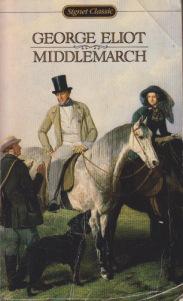 It is true that I have a fondness for nineteenth-century British novels.Even though they often lack a strong speculative element they tend to be gothic, at least if written by one of the Brontë sisters.I’d only ever read one of George Eliot’s novels before, and that was in ninth grade.Middlemarch has been on my list for many years, but due to its intimidating size I’ve kept putting it off.Now that I’ve read it I feel like I’ve accomplished something.I had no idea what the story was about in advance, and no idea how it ended.Unlike many pieces of literature of its time it hasn’t made a huge impact in pop culture, so this was the opportunity to lose myself for a few months in a world completely unknown.
It is true that I have a fondness for nineteenth-century British novels.Even though they often lack a strong speculative element they tend to be gothic, at least if written by one of the Brontë sisters.I’d only ever read one of George Eliot’s novels before, and that was in ninth grade.Middlemarch has been on my list for many years, but due to its intimidating size I’ve kept putting it off.Now that I’ve read it I feel like I’ve accomplished something.I had no idea what the story was about in advance, and no idea how it ended.Unlike many pieces of literature of its time it hasn’t made a huge impact in pop culture, so this was the opportunity to lose myself for a few months in a world completely unknown.
I’m not foolhardy enough to try to summarize an 800-page novel here, but one aspect that the reader can’t help but notice is the prominence of clergy.And not only prominence, but prestige.In a world built around the solid belief in different classes of individuals, where pride takes a place in marriages that are supposed to be within class, the clergy are minor nobility.Since this is the Church of England the vicars can marry and indeed, one such marriage sets off the tension that lasts throughout the hundreds of pages to come.The clergy of the time were often gentleman scholars—the role that was envisioned for Charles Darwin as a young man.Eliot plays on that idea with some of her preachers being amateur scientists.
The conflict—that now feels inherent—between science and religion has less to do with older forms of Christianity than it has to do with evangelicalism.A relatively new expression of Christianity, evangelicalism set itself against modernity and its science.Quite often today when commentators rail against “religion” it is really evangelicalism that they have in mind.In the world Eliot sketches, she sees no difficulties between a rational view of things and an ecclesiastical one.Clergy are often seen at the whist tables and taking long walks down country lanes.The distinction between them and the average citizen is that they have been to university to study.Today, in mainstream Christianity anyway, clergy are educated at least to the master’s level.They’re no longer among the minor nobility, however.Middlemarch has more than a hint of nostalgia to it, and the clergy roles show that clearly.
